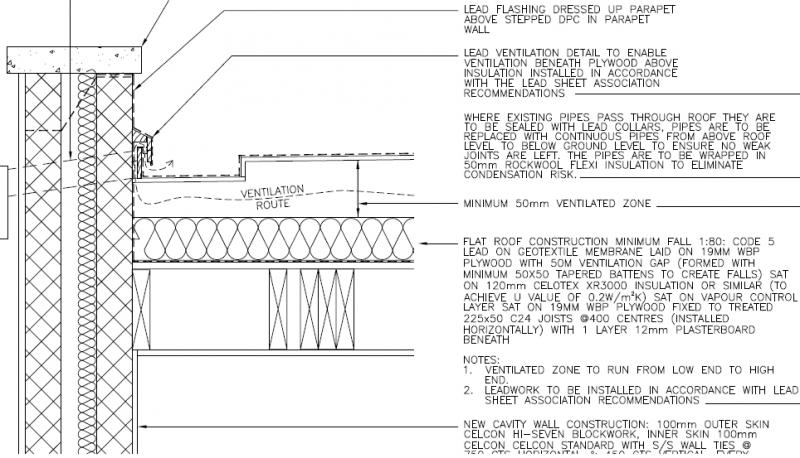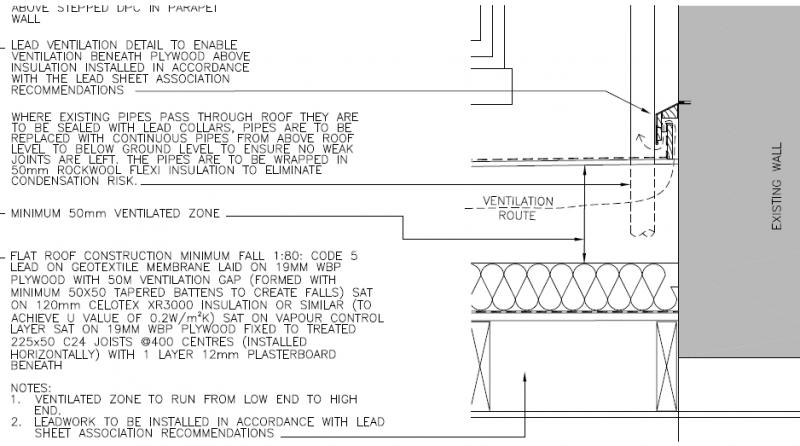You are using an out of date browser. It may not display this or other websites correctly.
You should upgrade or use an alternative browser.
You should upgrade or use an alternative browser.
All lead flat roof?
- Thread starter indus
- Start date
Indy,
Saw your post few days ago, but recently seem to get more bad days than good days, so am only just answering.
Regard your question. The breather membrane is a secondary line pf defence for water shedding. The 50mm air gap is for possible interstitial condensation leading to oxidisation and deterioration of lead cap..
Agree, if you have deep pockets lead cap is the best, and will last you a life time, providing that you sleep on it every night and buy a lion with big mane on running chain for day time protection, that is providing your trouble and strife likes big cats.
Due to lack of detail, can not comment any further Indy with regard to insulation. Construction, etc, except, construction is lot more complicated than straight forward felt or EPDM deck and with snow load, you are pitting fair weight up there even with code 5.
If it was mine Indy, I would go with EPDM, as it is only the birds that will see it and it will be half the price.
If you still want lead cap,
Regards oldun
Just noticed you have mentioned VCB. Yes, you need it, but there are various ways of doing it depending on cap and how much you want to spend.[wiki][/wiki]
Saw your post few days ago, but recently seem to get more bad days than good days, so am only just answering.
Regard your question. The breather membrane is a secondary line pf defence for water shedding. The 50mm air gap is for possible interstitial condensation leading to oxidisation and deterioration of lead cap..
Agree, if you have deep pockets lead cap is the best, and will last you a life time, providing that you sleep on it every night and buy a lion with big mane on running chain for day time protection, that is providing your trouble and strife likes big cats.
Due to lack of detail, can not comment any further Indy with regard to insulation. Construction, etc, except, construction is lot more complicated than straight forward felt or EPDM deck and with snow load, you are pitting fair weight up there even with code 5.
If it was mine Indy, I would go with EPDM, as it is only the birds that will see it and it will be half the price.
If you still want lead cap,
Regards oldun
Just noticed you have mentioned VCB. Yes, you need it, but there are various ways of doing it depending on cap and how much you want to spend.[wiki][/wiki]
Thanks Oldun
I think I'll probably go with the lead, it is expensive but I'm just not sure I can bare having a 'rubber/plastic' roof in my own home.
It's going to cost circa £200/sqm2, zinc would have been cheaper at £150/m2.
It's a lot of money, I'm going to think about it over the next few days and make a definite decision.
Thanks again
I think I'll probably go with the lead, it is expensive but I'm just not sure I can bare having a 'rubber/plastic' roof in my own home.
It's going to cost circa £200/sqm2, zinc would have been cheaper at £150/m2.
It's a lot of money, I'm going to think about it over the next few days and make a definite decision.
Thanks again
To vent the void or to not vent the void? That is the question: http://www.diynot.com/forums/viewtopic.php?t=197092
Hi Freddy
I did come across that old thread when I did a search. What did you end up doing?
The lead association does recommend the 50mm ventilation as did another lead specialist I contacted. So on balance given how much the lead costs and how little work the ventilation takes it would seem sensible just to vent.
Thanks
I did come across that old thread when I did a search. What did you end up doing?
The lead association does recommend the 50mm ventilation as did another lead specialist I contacted. So on balance given how much the lead costs and how little work the ventilation takes it would seem sensible just to vent.
Thanks
Well I detailed it as a pukka job though I have no idea what the builder ended up doing though. But it strikes me that if you're gonna go to the expense of having lead you may as well do it belt and braces!
@FMT,
I read up on your old post regarding the need for ventilation directly under the lead, even when adopting a warm roof.
When you asked the lead people why it needed venting, and what difference it was to a conventional warm roof, their reply was:
'because it's lead and impermeable'.
This struck me as odd. Logic dictates that you could equally well say that about bituminous felt, or asphalt, or EPDM, or whatever. Just seems strange that if you have a vapour barrier below the insulant, that lead is the only material that seems to need this additional ventilation above the insulant as well.
If it's to stop corrosion of the lead, as the experienced plumber in that thread said, then it makes you wonder just how durable this material is in warm-roof situations.
Just thinking aloud!
I read up on your old post regarding the need for ventilation directly under the lead, even when adopting a warm roof.
When you asked the lead people why it needed venting, and what difference it was to a conventional warm roof, their reply was:
'because it's lead and impermeable'.
This struck me as odd. Logic dictates that you could equally well say that about bituminous felt, or asphalt, or EPDM, or whatever. Just seems strange that if you have a vapour barrier below the insulant, that lead is the only material that seems to need this additional ventilation above the insulant as well.
If it's to stop corrosion of the lead, as the experienced plumber in that thread said, then it makes you wonder just how durable this material is in warm-roof situations.
Just thinking aloud!
I recall from when I was posting in that thread that condensation gathering on unventilated lead (ie underneath) causes corrosion because the condensation is effectively pure water and it lacks the carbon dioxide content of rainwater and so the process whereby the natural protection builds up on the exposed surface (exposed to the elements) cannot occur on the underside and is thus more vulnerable to corrosion, unless it is ventilated of course.
Generally a vapour barrier is not 100% resistant to vapour passing through it with all the joints and fixings penetrating it so without venting there will be a possibility of condensation occurring on its underside. Above a bathroom or kitchen and maybe with some downlighters the problem is exacerbated further.
Generally a vapour barrier is not 100% resistant to vapour passing through it with all the joints and fixings penetrating it so without venting there will be a possibility of condensation occurring on its underside. Above a bathroom or kitchen and maybe with some downlighters the problem is exacerbated further.
But bituminous felt, or asphalt, or EPDM are nothing like £200/m² and you would not expect them to have anything like the lifespan of lead. The same principle (ie a vent under the surface) is engaged on a zinc roof.This struck me as odd. Logic dictates that you could equally well say that about bituminous felt, or asphalt, or EPDM, or whatever. Just seems strange that if you have a vapour barrier below the insulant, that lead is the only material that seems to need this additional ventilation above the insulant as well.
This is still a warm roof (just detailed correctly), its just that there's a ventilated gap above the insulation.If it's to stop corrosion of the lead, as the experienced plumber in that thread said, then it makes you wonder just how durable this material is in warm-roof situations.
Indy,.
Will PM you
Regards oldun
Will PM you
Regards oldun
Thanks.
I have made contact with him
You won't be disappointed. Mention Bancroft Library to him, that was the last one he did for us.
If you put lead on a warm roof without venting it then I think the temperature would fluctuate to much causing it to fail earlier, the gap would help to stabilise that effect.
Thanks.
I have made contact with him
You won't be disappointed. Mention Bancroft Library to him, that was the last one he did for us.
Thanks. I mentioned Xenon to him and he didn't have a clue
DIYnot Local
Staff member
If you need to find a tradesperson to get your job done, please try our local search below, or if you are doing it yourself you can find suppliers local to you.
Select the supplier or trade you require, enter your location to begin your search.
Please select a service and enter a location to continue...
Are you a trade or supplier? You can create your listing free at DIYnot Local
Similar threads
- Replies
- 5
- Views
- 4K
- Replies
- 0
- Views
- 1K
- Replies
- 3
- Views
- 4K





